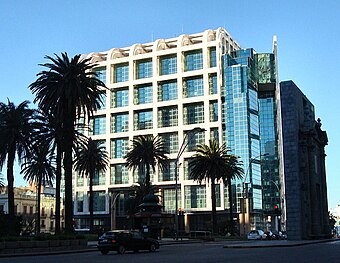| Portal | Participants | Templates | Tasks | Assessment | Popular Pages | Requests |
The Uruguay Portal
Uruguay (/ˈjʊərəɡwaɪ/ YOOR-ə-gwy, Spanish: [uɾuˈɣwaj] ), officially the Oriental Republic of Uruguay (Spanish: República Oriental del Uruguay), is a country in South America. It shares borders with Argentina to its west and southwest and Brazil to its north and northeast, while bordering the Río de la Plata to the south and the Atlantic Ocean to the southeast. It is part of the Southern Cone region of South America. Uruguay covers an area of approximately 176,215 square kilometres (68,037 sq mi). It has a population of around 3.4 million, of whom nearly 2 million live in the metropolitan area of its capital and largest city, Montevideo. The area that became Uruguay was first inhabited by groups of hunter-gatherers 13,000 years ago. The predominant tribe at the moment of the arrival of Europeans was the Charrúa people. At the same time, there were also other tribes, such as the Guaraní and the Chaná, when the Portuguese first established Colonia do Sacramento in 1680; Uruguay was colonized by Europeans later than its neighboring countries. The Spanish founded Montevideo as a military stronghold in the early 18th century due to competing claims over the region, while Uruguay won its independence between 1811 and 1828, following a four-way struggle between Portugal and Spain, and later Argentina and Brazil. It remained subject to foreign influence and intervention throughout the first half of the 19th century. From the late 19th century to the early 20th century, numerous pioneering economic, labor, and social reforms were implemented, which led to the creation of a highly developed welfare state, which is why the country began to be known as "Switzerland of the Americas". However, a series of economic crises and the fight against far-left urban guerrilla warfare in the late 1960s and early 1970s culminated in the 1973 coup d'état, which established a civic-military dictatorship until 1985. Uruguay is today a democratic constitutional republic, with a president who serves as both head of state and head of government. Uruguay is described as a "full democracy" and is very highly ranked in international measurements of government transparency, economic freedom, social progress, income equality, per capita income, innovation, and infrastructure. The country has fully legalized cannabis (the first country in the world to do so), as well as same-sex marriage, prostitution, and abortion. It is a United Nations, OAS, and Mercosur founding member. (Full article...) Selected article -The water resources management system in Uruguay has been influenced by the general sense of water as an abundant resource in the country. Average annual rainfall is 1,182 mm, representing a contribution of 210 km3 annually throughout its territory. In 2002, the per capita renewable water resources was 41,065 cubic meters, way above the world average 8,467 m3 in 2006. Uruguay also shares one of the largest groundwater reserves in the world, the Guarani Aquifer, with Brazil, Argentina, Paraguay. The Guarani aquifer covers 1,200,000 square kilometers and has a storage capacity of 40,000 km3. The institutional framework for water resources management consists of sectoral governmental agencies at the national and regional level. The Water Code, Decree No 14.859 of 1978, establishes the legal framework for water resources management in Uruguay completed by sectoral laws for agriculture, industrial water use, energy production and water supply and sanitation. (Full article...) Selected picture - The Executive Tower of Montevideo, is the seat of the executive power of the government and the working place of the President of Uruguay. It is 56 meters tall and was inaugurated in its present form in 2009. The construction of the original building started in 1965 and was meant to be used as the Palace of Justice, but the project remained halted until 2006.
Did you know -
CategoriesSelect [►] to view subcategories
People -José Pablo Torcuato Batlle y Ordóñez ([ˈbaʒe] or [ˈbaʃe]; 23 May 1856 in Montevideo, Uruguay – 20 October 1929), nicknamed Don Pepe, was a prominent Uruguayan politician, who served two terms as President of Uruguay for the Colorado Party. He was the son of a former president and was widely praised for his introduction of his political system, Batllism, to South America and for his role in modernizing Uruguay through his creation of extensive welfare state reforms. In 1898, he served as interim president for a few weeks. He was later elected to the presidency for two terms: from 1903 to 1907 and from 1911 to 1915. He remains one of the most popular Uruguayan presidents, mainly due to his role as a social reformer. Influenced by Krausist liberalism, he is known for influencing the introduction of universal suffrage and the eight-hour workday, as well as free high school education. He was one of the main promoters of Uruguayan secularization, which led to the separation of the state and the Catholic Church. Education started a process of great expansion from the mid-to-late 19th century onward. It became the key to success for the middle class community. The state established free high school education and created more high schools through the country. The university was also opened to women, and educational enrollment increased throughout the country. Batlle also, in the words of one source, "revitalized the Colorado party and strengthened its liberal tradition, giving way to ideas of general and universal interest, and favoring the right of the working class to organize and put forward just demands. (Full article...) General imagesThe following are images from various Uruguay-related articles on Wikipedia.
Related portalsTopicsRecognized content
|
|||||


































